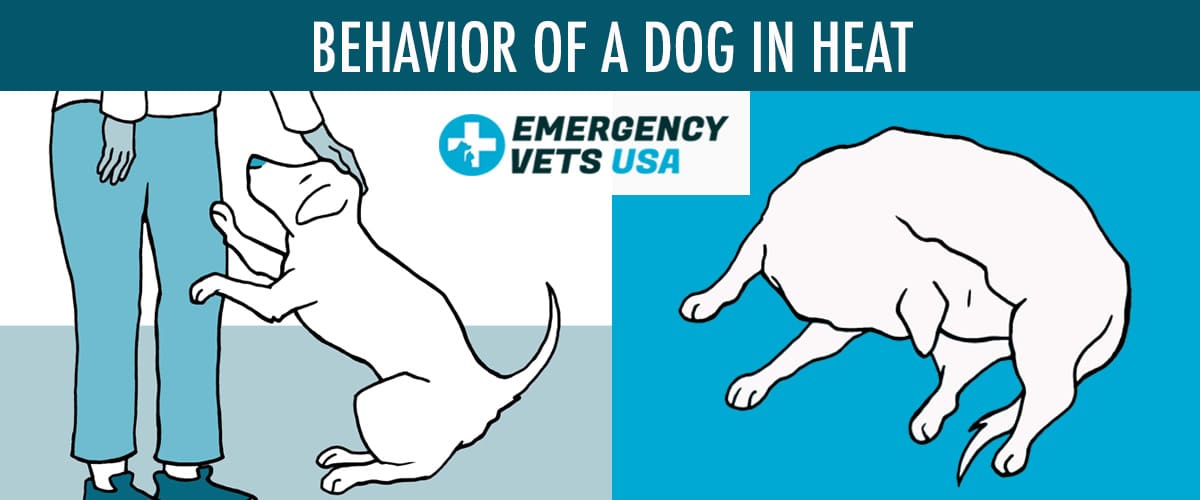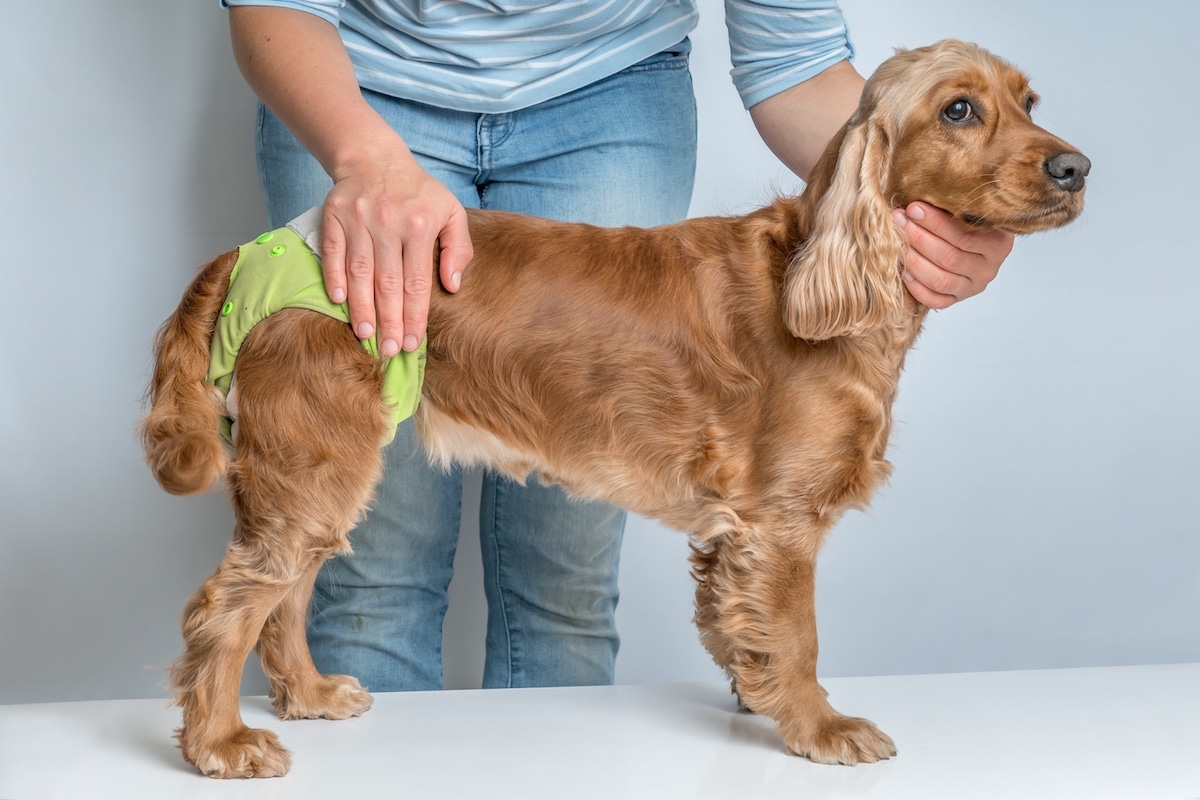Common Behaviors Of A Female Dog In Heat – Our Vet Explains
If you have never owned a female dog before then you may have lots of questions, particularly as she matures from a puppy into a young adult. During this time, she will have her first oestrus, otherwise known as coming on heat or having her season. This all refers to the same thing, the time when a female dog is at her most fertile and is ready to be mated.
It’s important to understand this process, as you will probably want to avoid a pregnancy occurring. Even if you plan on breeding your dog, you will still need to wait until she’s old enough to safely have a litter. This means avoiding accidental mating from occurring until then.
In this article, we will explore the tell-tale behavioral signs that your dog could be in heat, as well as whether neutering is a good option for your dog.

How A Dog’s Heat Cycle Works
First of all, it’s important to understand how a heat cycle works in dogs. Most female dogs will have their first season when they reach puberty, often between 6 and 12 months of age. Smaller breeds such as terriers or miniature poodles are likely to reach this stage of development earlier than large breeds like mastiffs or Saint Bernards.
The physical signs of a season include:
- An increased volume of vaginal discharge
- A bloody vaginal discharge, progressing to a straw color
- Enlargement of the vulva (external genitalia)
- A change in tail position – she may curl it to one side to allow males access
- Attractiveness to male dogs
The heat cycle can be divided into 4 main states:
1.) Proestrus
This is the time when you may start to notice changes to your dog’s behavior as well as physical clues like a swollen vulva and bloody discharge. Estrogen from the developing follicles in her ovaries continues to rise in her bloodstream and is the cause of many of her behavioral and physical changes.
2.) Oestrus
Oestrus is when your female dog will be receptive to male attention. Her discharge turns from bloody to a straw color, indicating that she is at her most fertile. A surge in luteinizing hormone causes the release of eggs to occur (ovulation) from the follicles in her ovaries and if your dog is mated around this time then she could become pregnant. A corpus luteum is left behind on the ovary after this occurs which releases progesterone. This hormone helps to maintain a healthy pregnancy.
3.) Dioestrus
During this state, your dog’s body will either be returning to normal, or she will be carrying a pregnancy. She will no longer have a vaginal discharge and her external genitalia will return to their normal size. Progesterone levels will remain elevated for a while before gradually declining.
4.) Anoestrus
This is an inactive period where your dog will not be experiencing any large hormonal shifts. This usually lasts around 4 months or so, until proestrus comes around again and estrogen levels start rising.
These hormonal changes help to explain why your dog’s behavior might become altered around the time of her heat, which we will explore further.
8 Common Behaviors Of A Female Dog In Heat
As well as the physical signs of being in heat, many female dogs give behavioral clues too. The following behavioral changes are often noted just before and during oestrus:
1.) Changes in appetite
Many dogs can lose their appetite when they are in season, mainly because they’ve got more important things on their mind! All her focus is on mating at the moment, so food can lose its appeal.
Continue to offer her normal food, but you can also try and tempt her with some healthy snacks during this time such as lean strips of cooked chicken or some cooked egg.
2.) Increased urination
Female dogs give off scent markers in their urine, known as pheromones when they are in oestrus. This lets male dogs in the area know that they are ready to be mated.
This scent marking can be a little annoying to us, particularly if your pet wants to stop every couple of minutes to pee, but it is a natural way for her to communicate. Some dogs in heat may even lift one of their legs when urinating near a male.
3.) Mood swings
Your dog may be grumpy towards other dogs, particularly females, while she is in heat. She may be more anxious and highly strung than normal, possibly showing signs of aggression too.
On the flip side, she may be flirting more than usual, holding her tail to one side, and allowing males to sniff her. The hormones involved in reproduction can make even the most good-natured dog appear to act out of sorts during this time.
4.) Restless behavior
Some dogs can become quite restless when in season. You may notice this in particular when you are indoors with your pet. She might be up at the window one minute, at the back door the next, seemingly unable to settle while she’s thinking of ways to find her mate.
She may also be more vocal or whine more than usual.
5.) Clingy behavior
Your dog may look to you for some extra affection when she’s having her season. Being petted may also help to disperse her pheromones too. These aren’t something that we can smell, so don’t be afraid to give your dog some extra snuggles if she wants them at this time.
6.) Increased grooming
Many female dogs will start licking excessively at their private areas, to keep them clean and clear up excessive vaginal discharge. She may also be feeling a little uncomfortable down below due to the swelling in her genitals.
7.) Seeking a mate
Hormonal changes drive your dog to try and find a mate when she is fertile. As dogs only come in heat twice a year, she only has a short amount of time in which to get pregnant.
During this period she will be very keen to try and find a willing male! This may mean she ends up straying away from you more on walks or even trying to escape from your yard at home. This behavior can be especially problematic if you don’t want her to get pregnant!
8.) Mounting behaviors
Some female dogs will start mounting things like their bedding, soft toys, or even your leg! The hormones involved in reproducing may lead to sexual urges, often displayed as excessive humping during the time she is in season.
Steps To Take When Your Dog Is In Heat

There are several things you can do to manage your dog when she is in season, especially if you want to stop an accidental pregnancy from happening.
- Keep your dog on a leash when out walking in public. This gives you some control and stops her running off to find a mate. Sticking to private property or finding quieter walks may be a safer bet at this time too.
- Secure your property to ensure she doesn’t escape, and that any potential mates don’t get in! Dogs can be very determined to get to each other, so make sure your yard is in good shape and that gates are kept shut, to avoid accidents from happening.
- Remember that siblings can and will mate. If you own a brother and a sister, then an accidental pregnancy could occur if you are not careful. Always keep them apart while she is in season.
- Consider dog hygiene pants. These act a bit like a diaper and will help to prevent mess at home but may also discourage mating from occurring.
- Your dog’s hormonal changes may make training difficult during this time. Try not to introduce any new commands or tricks during this period as she may struggle to concentrate on the task at hand.
- Give training or agility classes a miss during her heat. Not only will she struggle to concentrate but she could be a distraction to the other dogs in the class.
Neutering/Spaying Your Dog
Many owners choose to neuter or spay their dog. This not only prevents any unwanted pregnancies but also stops your dog from ever entering oestrus again. This means behavioral changes discussed earlier will no longer occur either, which may make your dog easier to manage. As well as this, there are some good health benefits to having your dog spayed.
Removing her ovaries and uterus prevents a condition known as pyometra. This potentially fatal illness often affects older female dogs, though it can be seen in younger animals too. Hormonal changes to the lining of the uterus can make a bacterial infection much more likely to occur.
The uterus fills with pus and your dog will become very sick without intervention. Some pyometra cases can be medically managed, but surgery is often advised as it is curative and stops the problem from occurring again in the future.
Spaying your dog at an early age can help to reduce her risk of developing mammary tumors in later life. It is also recommended in cases where mammary gland carcinoma has been diagnosed, increasing your dog’s chances of survival.
Spaying usually involves surgical removal of the ovaries and the uterus through a small incision on your dog’s abdomen. It is usually a day procedure, with your pet coming home from their surgery later the same day. You will need to keep her rested for at least 10 days after the surgery.
When deciding whether to spay or neuter their dog, many owners worry that it will change their dog’s personality, but this is not the case. Changing the body’s ability to produce these hormones just alters the sexual behaviors your pet displays, but won’t change their character at all.
You should speak with your vet about the best time to have your dog spayed, and any specific questions you may have about the surgery itself.
Summary
When a dog is in heat she may show several behavioral changes. Some of these can be a bit frustrating, but hopefully understanding the reasoning behind them can help you to manage things better.
You must always speak to your veterinarian if you have any concerns about your dog, or if you are considering having your dog neutered.
If your dog happens to get pregnant, you can find out when she is due by using our dog pregnancy calculator. This calculator will give you an idea of when to expect her new puppies to arrive. That way you can be more prepared for when the day comes.
FAQs
What Is Dog Heat?
The term ‘dog heat’, also known as oestrus, describes the time when a female dog is at her most fertile. Hormonal changes lead to her releasing eggs from her ovaries but also cause several physical and behavioral changes. You may notice that her vulva is swollen, she has a vaginal discharge, and she is acting out of character.
What Do You Do When Your Dog Gets Her Period?
Female dogs don’t have a period in the same way that people do. When a dog has bloody vaginal discharge, it is a sign that she is about to enter a fertile time called oestrus. If you don’t want her to become pregnant, then keep her away from any intact male dogs during this time.
How Often Do Dogs Go Into Heat?
Dogs usually go into heat (oestrus) twice a year, approximately every 6 months. This can vary slightly between breeds though and can also be affected by age, and any underlying health issues.
Resources:
- en.wikivet.net
- dvm360.com
- pubmed.ncbi.nlm.nih.gov
- aspca.org
- msdvetmanual.com
- pubmed.ncbi.nlm.nih.gov

Rebecca is a companion animal vet who lives and works in the UK. She graduated from The Royal Veterinary College (London) in 2009 and since then has gained a wealth of experience in all aspects of veterinary care. She has also recently completed a British Small Animal Veterinary Association postgraduate qualification in medicine, passing with commendation. Outside of work, she enjoys writing on a variety of pet health and behaviour topics, as well as spending time with her young family and her flat coated retriever, George.
Rebecca is currently a Veterinary Surgeon at Vets4Pets
